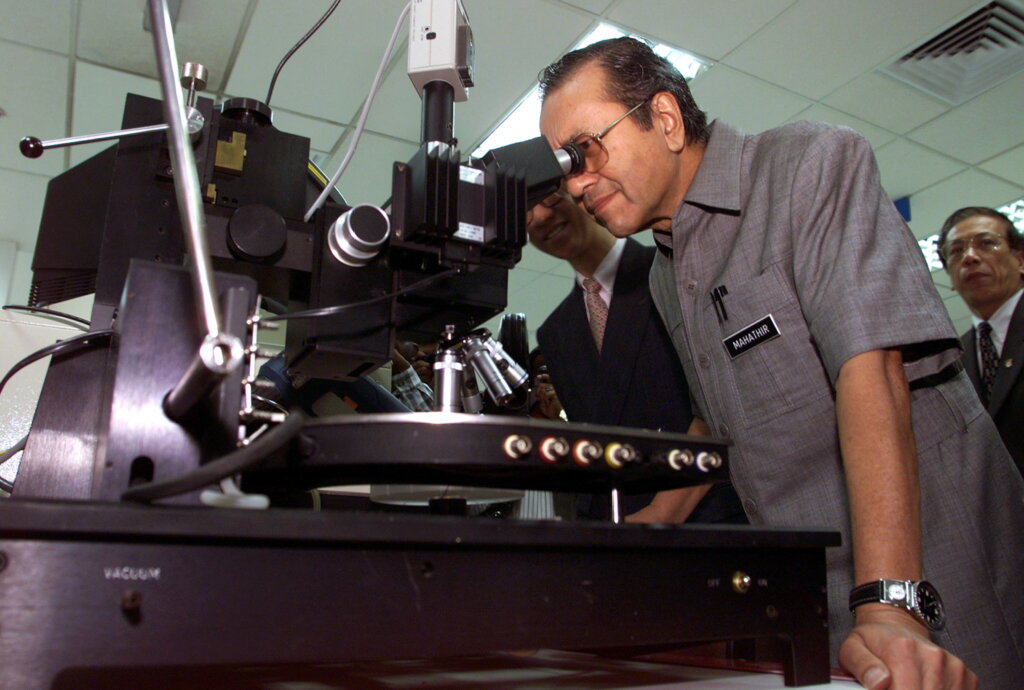
Intel has a strong presence in Malaysia, investing over US$5 billion since 1972 and employing over 15,000 people.Source: Shutterstock
How Intel pioneered the semiconductor industry in Malaysia
|
Getting your Trinity Audio player ready... |
- Intel has a strong presence in Malaysia, investing over US$5 billion since 1972 and employing over 15,000 people.
- The chip giant has earmarked another US$7 billion for the next ten years, mainly to increase the size of its operations in Penang and Kulim, Kedah.
- Malaysia will also soon host Intel’s first overseas advanced 3D chip packaging facility.
The story of Intel Corp in Malaysia began in 1972 when the company established its first offshore assembly and test facility outside the United States. The decision to set up operations in the Southeast Asian nation marked the beginning of a transformative journey that would impact Intel and the nation’s semiconductor landscape.
The US chip giant started with a 5-acre assembly plant in Penang, a Malaysian state on the northwest coast of the Peninsular. As per Intel’s records, by 1975, the A1 Intel Malaysia site facility had a workforce of approximately one thousand individuals and had become an indispensable component of the chip giant’s manufacturing network. The AI plant started with assembling just the 1103 DRAM integrated circuit.
However, a fire in the May of that year led to the company’s decision to reconstruct a new facility the following year. The fire resulted in damages amounting to US$2.5 million, more than Intel’s initial investment in Penang three years earlier. It wasn’t until 1976 that production resumed in Penang.

On May 1, 1975, a little after 9 a.m. a fire broke out in Intel Penang’s mold room, probably the result of a faulty light. Source: Intel
“The new plant’s construction had been a herculean effort in its own right,” Intel said in a blog posting. In the following years, Intel’s presence in Penang expanded significantly in both its physical footprint and the scope of duties. It incorporated a comprehensive testing facility and established a dedicated center for development and design, all while maintaining its original function as an assembly site. Its workforce experienced substantial growth during this period, multiplying several times over.
It took about two decades since the Penang A1 site came up for Intel to establish another site to manufacture motherboards. The facility still resides in the town that borders Penang, called Kulim. The facility was strategically located within the Kulim Hi-Tech Park, Malaysia’s first high-tech industrial park, which officially opened in 1996.
Today, the site encompasses five buildings, assembles processor packaging, and is a critical operations center for mobile modules. Intel Kulim is located a 45-minute drive away from Intel Penang.
The role of Malaysia’s factory in Intel’s supply chain

Malaysian then Prime Minister Mahathir Mohamad takes a closer look at an Intel microchip during his tour of a newly launched Intel Corp. building 02 July 1999, in the northern state of Penang. (Photo by JIMIN LAI / AFP)
Intel’s facilities in Malaysia occupy a pivotal role within the company’s global manufacturing network. This marks a significant departure from the early days of the A1 plant, which initially focused on assembling the 1103 DRAM integrated circuit. Although Intel operates wafer fabs across the globe that create a thin slice of semiconductor, known as a wafer, all of them will eventually be sent to the chip giant’s Malaysia campuses, both in Kulim and Penang.
Raymond Saw, a writer from SoyaCincau, visited both Intel facilities in Malaysia recently and shared some details on how things are being done there. In his article, he stated that the wafers initially reach the campus known as Kulim Die Sort and Die Preparation (KMDSDP). The campus space would be illuminated with distinctive yellowish sepia lighting at all times, a precaution to prevent the deterioration of the Mylar polyester sheets that secure the circular wafers in position.
The wafers will go through two stages in the Kulim campus: preparation and sorting. After those procedures are completed, the processed dies are shipped to Intel’s Penang Assembly and Test (PGAT) facility across the Penang Strait for additional processing. Once the final processing steps are completed, the chips will go through ‘testing’ before it is considered completed.
They would undergo extensive testing before packaging and sale. To identify faulty chips, the finished CPU is subjected to a burn-in test involving high temperatures and voltages. Those that pass this stage undergo further testing, which includes checking electrical traces and overall functionality. Finally, a platform performance verification phase simulates real-world conditions using machines to ensure the processors operate as intended.

Layout of Penang campus. Source: Intel’s website
Jobs and positions at Intel Malaysia
Since 1972, Intel claimed that it has invested over US$5 billion in its facilities in Malaysia, employing over 15,000 people in its largest assembly and test manufacturing facility. Not only is it Malaysia’s largest product design and development center, but it is also one of two Intel shared services hubs supporting global operations.
According to SoyaCincau’s report, the chip giant claims 40% of their 15,000 employees are women, with AK Chong, the current Managing Director of Intel Malaysia, being the first woman to hold the position. Another interesting fact shared by Intel is the fact that Intel Malaysia has a workforce that comprises 98% Malaysians.
Intel also plans to further anchor Malaysia’s position as an advanced manufacturing hub with its latest advanced packaging facility, estimated to be completed by next year. The new expansion facility, the Pelican Project, was unveiled when Intel announced its commitment to investing more than US$7 billion into the country over the next ten years.
Earlier this year, Intel also revealed that another factory is being built in Penang, and it’ll be Intel’s first overseas facility for advanced 3D chip packaging, known as Intel’s Foveros technology. Malaysia will eventually become Intel’s largest production base for 3D chip packaging, Robin Martin, corporate vice president for manufacturing supply chain and operations, told reporters in August this year.
In short, Intel is expanding its operation in Malaysia as a whole and creating thousands of job opportunities while developing the local semiconductor industry.
READ MORE
- Safer Automation: How Sophic and Firmus Succeeded in Malaysia with MDEC’s Support
- Privilege granted, not gained: Intelligent authorization for enhanced infrastructure productivity
- Low-Code produces the Proof-of-Possibilities
- New Wearables Enable Staff to Work Faster and Safer
- Experts weigh in on Oracle’s departure from adland


